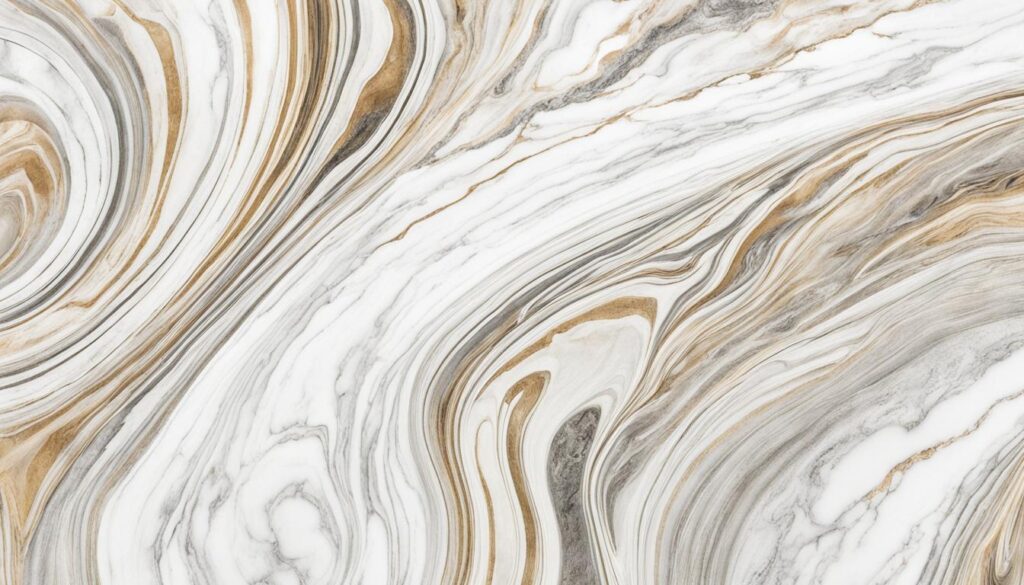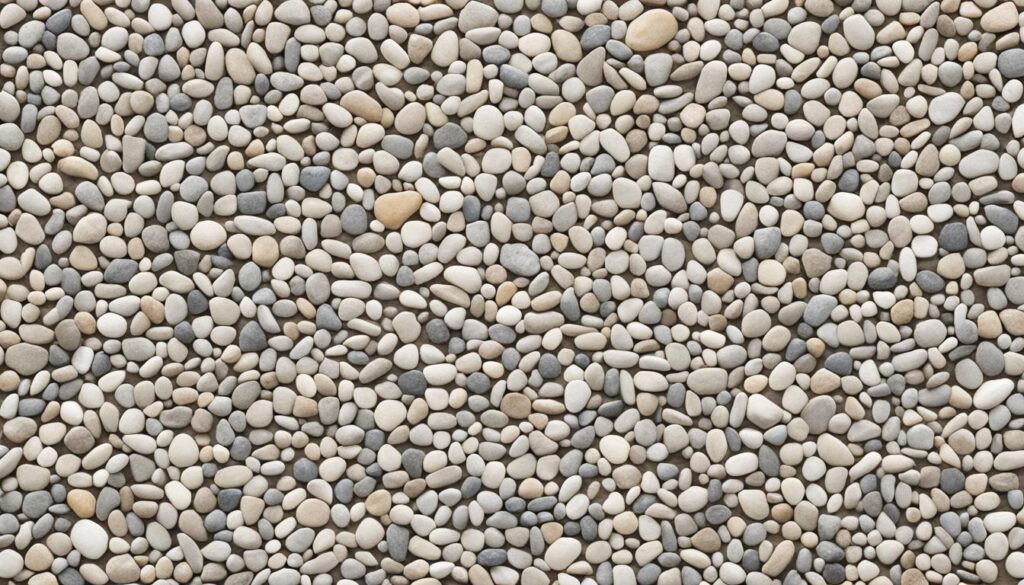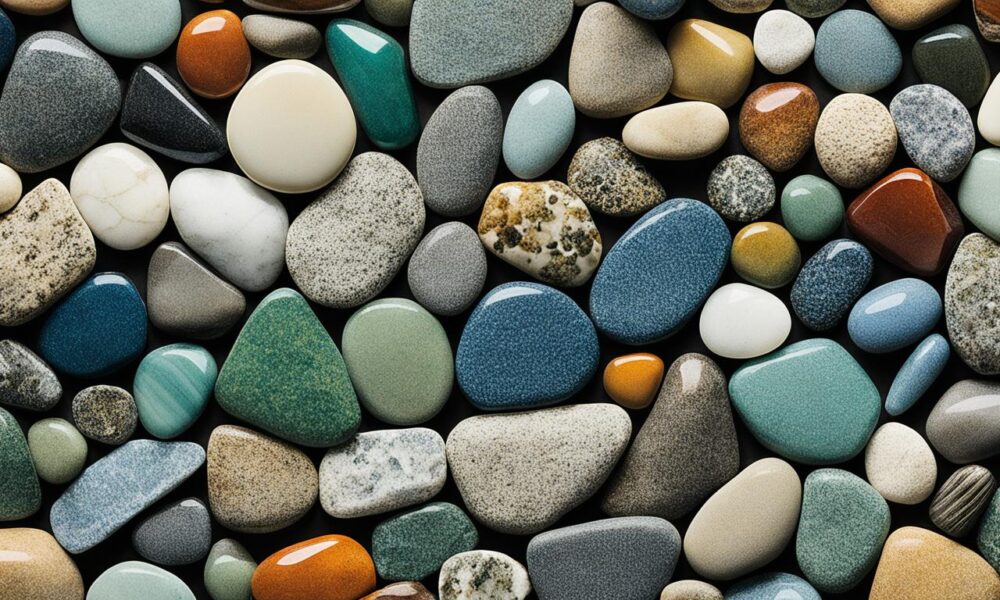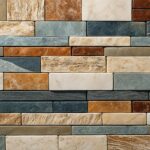Natural Stones Types – Discover Different Varieties
Look into the amazing world of natural stones, each having its own special traits and allure. You will find a vast selection, from the classic beauty of marble to granite’s tough endurance1. These stones take shape over millions of years, bringing us a wide array of colors, designs, and feels2.
Among the popular in building and design are limestone, marble, slate, travertine, and granite3. Granite stands out for kitchen counters for its sturdiness and ability to resist wear. Marble is loved for its glow and it’s easy to care for on counters, floors, and walls1. Sandstone shines for its high quality and is often seen in window sills, cladding, and outside areas1.
Then there’s quartzite, offering great strength and toughness for uses like counters and floors1. Travertine, with its varied finishes, is perfect for looks and as flooring. Limestone feels soft but stands strong against mold and germs, so it’s often used in kitchens1.
Natural stones are grouped as magmatic, metamorphic, and sedimentary types3. Granite and basalt fall into magmatic, forming from cooling magma. Marble and slate are metamorphic, changing from existing rocks under intense conditions23. Then, sedimentary rocks like limestone, dolomite, and others form over time through deposits3.
The natural stone industry uses various finishes to improve looks and use of the stones. A polished finish looks shiny and highlights the stone’s beauty1. A honed finish is smooth but not shiny, good for grip, made by sanding. Tumbled stones have a worn and rustic feel, also good for grip, made by tumbling1.
Key Takeaways
- Natural stones offer a wide range of options for various applications, each with unique characteristics and charm.
- The main types of natural stones used in building and design include limestone, marble, slate, travertine, and granite.
- Natural stones are classified into magmatic rocks, metamorphic rocks, and sedimentary rocks based on their formation.
- Various finishes, such as polished, honed, and tumbled, enhance the beauty and functionality of natural stones.
- Natural stones are formed through geological processes over millions of years, resulting in diverse colors, patterns, and textures.
Introduction to Natural Stones
Natural stone has been quarried for centuries from the earth. It’s used in building and decorative purposes. This organic rock is a solid mix of minerals. It’s very useful for many things.
The way natural stone is made is truly intriguing. Thousands of years ago, mineral gases swirled inside the Earth. When the Earth cooled, these gases turned into a solid mineral core and crust.
About the same processes, such as pressure and heat. This made the vast rock beds we see today4.
What is Natural Stone?
Natural stone is an organic rock taken from the earth. It’s used in building and for looks. It’s made of minerals4. There are nine common types: Granite, Limestone, Marble, plus others5.
How Natural Stone is Formed
Natural stone comes from mineral gases inside the Earth long ago. As it cooled, these gases made a solid mineral core and crust. Over time, pressure, expansion, and heat changed this into rock beds4.
Many quarries today get their stones from these rock beds.
Some rocks sold as marble are actually limestone. And granites may not really be granite. But, the Marble Institute of America says there are no “bad stones.” Just pick carefully for what you need5.
| Natural Stone Type | Characteristics | Common Applications |
|---|---|---|
| Granite | Highly resistant to weather, most durable stone for buildings4 | Used in building and for looks4 |
| Marble | Luxurious and each piece is unique4 | Mainly for looks and sculptures |
| Limestone | A type of sedimentary rock, sometimes holds fossils4 | For various building uses4 |
| Travertine | Has pores, made mostly of calcium carbonate4 | Used inside and outside buildings4 |
When you choose natural stone, think about how it will change over time. Choose based on what changes, like charm or patina5. It’s key to research well for the best stone for your use5.
Marble: Elegance and Sophistication
Marble is a stunning rock made of recrystallized carbonate minerals. These minerals are usually calcite or dolomite. It’s known for its elegance and beauty6. You can find it in many modern decorations and designs6. Around 4% of natural stones used in construction are marble. It shows how much people like to use it in building work7.

Characteristics of Marble
Marble changes naturally under a lot of pressure and high heat. This creates new textures and structures in the rock. There are many different types of marble, each with its own features. It’s one of the cheaper natural stones and is quite common. Marble is strong and can be used in many ways7. Its smooth surface is easy to clean, and it looks great when polished.
Popular Marble Varieties
There are so many kinds of marble. Here are a few favorites:
- Carrara marble, from Carrara, Italy8
- Calacatta marble, a special Italian marble with unique veins8
- Statuario marble, very rare and valuable8
- Thassos marble, from Greece, known for its pure white color8
- Makrana marble, from India, used in making monuments8
- Volakas marble, a Greek marble with white and gray patterns8
Marble also comes in white, black, and many different colors. Each color has its own beauty and adds to marble’s charm and sophistication.
Applications of Marble in Home Design
Marble is used a lot in construction. It’s in sculptures, floors, countertops, and more. In fancy buildings, marble is a common choice because it looks elegant. It makes up about 12% of the natural stones used in these designs7.
Using marble in homes makes them more valuable. Property values can go up by 20% just by having marble in the design. People see the luxury in marble and its companions7.
| Application | Benefits |
|---|---|
| Flooring | Durable, easy to clean, and adds a touch of elegance to any space |
| Countertops | Heat-resistant, scratch-resistant, and provides a luxurious look |
| Wall Cladding | Creates a stunning visual impact and protects walls from moisture |
| Sculpture | Allows for intricate detailing and showcases the beauty of the stone |
Making marble helps the building industry grow. Demand for marble is going up.7. More companies are using recycled marble and other natural stones. This is to help the planet and cut down on waste7. The Marble Doctor knows all about taking care of marble. Taking care of it for the long term is really important8.
Choose marble from places that take care of the environment. This is important for the future. Marble is beautiful, strong, and always in style. It’s a top pick for anyone who wants their place to look fancy and stylish.
Granite: Durability and Versatility
Granite is a coarse-grained igneous rock. It’s mainly made up of orthoclase and quartz. This makes it very strong and needs minimal care. It’s the top of the Mohs scale for hardness. That means it’s great against scratches and can hold up to a lot of wear and tear. This is why it’s perfect for things like countertops and floors, as well as outdoor projects910. Over 2/3 of the granite used worldwide comes from China, India, and Brazil11.
Granite can last for many years with the right care. It’s so durable because of how dense and hard it is9. Its hardness score on the Mohs scale is around six or seven. That’s great for not only resisting scratches but also for handling changes in temperature without breaking. Granite can also handle heat up to ±250°C (±480°F). Plus, it’s better at keeping bacteria away than other types of countertops1011.
Properties of Granite
Granite is a top pick for places where a lot of people and activity go on. It’s really hard to scratch because its minerals are very tough. Plus, it hardly absorbs liquid, making stains an uncommon problem11. Granite tiles are a good choice because they are flexible, strong, and water-resistant. This makes them easy to keep clean using just regular cleaning products.
Common Granite Colors and Patterns
Granite comes in many colors and patterns thanks to its mineral mix. You can find many shades that work well with different design styles9. Some usual colors are:
- Black
- Blue
- Brown
- Beige
- Green
- Pink
- Red
- White
- Yellow
Each color option has its own unique look and feels. This means you can personalize your space to match your style, whether it’s modern or more traditional9.
| Property | Value |
|---|---|
| Mohs Hardness Scale Rating | 6-7 out of 1010 |
| Heat Resistance | Up to ±250°C (±480°F)11 |
| Absorption Rates | 0.05% to 0.40%11 |
| Scratch Resistance | Excellent11 |
When picking natural stone, you need to think about cost, how long it will last, and how to take care of it9. It’s important to look at different types of stone to find what’s best for your needs. Using stone from close by is also great for the planet. It means less pollution from shipping and it’s better for the environment9.
Limestone: A Timeless Classic
Limestone is a rock used for centuries in building and decorating. It’s mainly made of calcium carbonate and has things like shell pieces and tiny fossils in it12. This rock forms slowly over millions of years in oceans and other water places12.
Formation and Composition of Limestone
Limestone has many types, like Chalk and Travertine. Each kind has a different look and use12. Builders use it to make everything from roads to buildings13. The little shell pieces and fossils in limestone make it special12.
Advantages of Using Limestone
Limestone is great for building. It lasts long, doesn’t mind the weather, and looks good inside and outside13. Its off-white color and old look are perfect for a classic style14. Limestone also keeps places cool because it’s good at moving heat14.
Limestone blocks are also very tough, don’t get slippery, and don’t need much looking after13. This makes them perfect for outdoor areas like driveways and pool decks13. They make any outdoor space look nice and add value to your property13.
| Advantage | Description |
|---|---|
| Durability | Limestone is strong and stands up to the weather, good for inside and out. |
| Versatility | With its different types, limestone can be used in many ways including building roads. |
| Aesthetic Appeal | Its off-white color and old look create a timeless and beautiful European feel. |
| Heat Conductivity | Limestone’s good at moving heat, keeping buildings cool. |
| Low Maintenance | Limestone blocks are easy to care for, making upkeep simple. |
To sum up, limestone is a favorite for many because it lasts, it looks good, and it’s good at many things. From ancient times to today, people love using limestone for good reasons12.
Other Types of Natural Stone
Marble, granite, and limestone are well-known, but there are more natural stones to explore15. Travertine, quartzite, onyx, and bluestone are some examples. They all have unique qualities and uses15.
Travertine: Unique and Exotic Beauty
Travertine forms near hot springs and in caves. It comes from limestone that takes in calcium carbonate15. This stone is tough and great for floors in kitchens and bathrooms. You can get it in many colors and styles15.
Quartzite: Strength and Diversity
Quartzite comes from sandstone under great heat and pressure. It’s very strong, versatile, and doesn’t soak up water or stains, which is why people love to use it16. It mostly looks white to grey, but you can find it in pink and red, too16.
Onyx: Mystical and Translucent
Onyx is formed by layering quartz together. It’s somewhat see-through, like certain marbles15. Because of its unique look and mystical vibe, people use it a lot in decorations and special pieces.
Bluestone: Versatile and Durable
Bluestone includes a range of different rocks. People use it for paths, steps, and even driveways because it lasts and looks nice15. It works well both inside and outside.
| Natural Stone | Characteristics | Applications |
|---|---|---|
| Travertine | Durable, impact-resistant, various shades and textures | Kitchen and bathroom floors, heavy-use surfaces |
| Quartzite | Strong, versatile, water-resistant, stain-proof, diverse colors | Countertops, flooring, wall cladding |
| Onyx | Translucent, unique appearance, mystical quality | Decorative purposes, statement pieces |
| Bluestone | Durable, versatile, beautiful texture and colors | Walkways, pathways, steps, driveways, paving projects |
Each stone type has its good and bad points for different jobs15. Things like how tough they are, what it takes to care for them, and their price change how people use them15. Knowing about these stones helps homeowners and designers pick the right one for their needs.
Natural Stone Finishes and Applications
Natural stone finishes have many options to improve any space’s look and use. The choice between rough, textured to smooth, and polished depends on the stone and what look you want. Using natural cleft stones is the least expensive way to add beauty to a place17. On the other hand, polished finishes bring out the stone’s natural colors and textures, adding value to properties17.

Various Finishes for Natural Stone
Tumbled stones give an antique look with their aged effect, perfect for wet spots17. Bush-hammered stones have rugged textures that suit outside walls17. Sandblasted stones offer good grip for outdoor floors17. Mushroom finish gives a wild, yet cozy look, mainly for exteriors17. Leather finishes mimic actual leather, adding both feel and style17. Sawn stone finishes come from cutting, creating uneven surfaces17. Honed finishes are smooth but not slippery, nice for everywhere17. Finally, flamed finishes make the surface rough and porous, perfect for gardens and paths17.
A study on September 16, 2015, identified ten natural stone finishes18. Polished finish suits indoor walls, floors, and kitchen spaces18. Bush-hammered gives grip on exteriors with its rough surface18. A leather finish stands out by being soft and cozy, especially on granite18. If exposed to heat, a stone gets a flamed finish, good for outside use18. Sawn stones are for external spaces, making floors and paths18. Tumbled stones, like sandblasted, show beautiful color with a worn look18.
Natural Stone Tiles and Pavers
For paving, use stones like travertine and limestone for their strength. Mix different sizes with French and Opus layouts for a unique feel. Stone tiles in rectangular or square shapes are great for floors and walls in many sizes and styles.
Today, big stone slabs are in for kitchen counters, enhancing any kitchen’s look and style. By polishing, a stone’s true color and veins come to life19. Brushing creates a comfy feel with wire wheels and brushes, making it soft and textured19. Natural cleft shows up in stones like bluestone naturally, adding a unique touch19.
For kids’ baths, pick finishes that are safe and not slippery19. In places with lots of movement, like pool areas, use finishes like flamed or sandblasted for safety19. When choosing for counters, think about cleaning and the look you want. Knowing the advantages and disadvantages of each finish helps find the best mix of beauty and function19.
Choosing the Right Natural Stone
Choosing the right natural stone is key for your home or business. Remember, each stone is unique. You’ll find differences in color, veining, texture, and more. This makes every piece special20.
Options like marble, granite, quartzite, and soapstone stand out20. Marble is timeless and used indoors or out. Granite is great for its strong, easy-to-clean surface. Travertine is ideal for different spots, and limestone handles indoor and outdoor life well20.
Consider the where, how, and why when picking natural stone20. Marble, for instance, isn’t for damp or salty areas. Soapstone shines in heated spaces, like kitchens and baths20.
Stone is either siliceous or calcareous, depending on its minerals. Some stones are harder than others. This can affect where you use them and how they last21.
| Stone Type | Pros | Cons |
|---|---|---|
| Marble | 8 different points | 6 different points |
| Granite | 9 different points | 4 different points |
| Soapstone | 8 different points | 6 different points |
| Quartzite | 8 different points | 4 different points |
| Serpentine | 5 different points | 4 different points |
| Slate | 8 different points | 7 different points |
| Limestone | 7 different points | 4 different points |
Table showcasing the pros and cons of various natural stone types.14
Resisting stains is a big deal with natural stone. Also, set a budget before choosing. They can be pricey but last a long time20.
Don’t see stone differences as flaws. They’re what make the stone stand out. Embrace these traits to make your place unique and beautiful.
Conclusion
Natural stone brings timeless beauty to any home or project. It offers durability and unique features. There are many options, from classic marble to strong granite and beyond. Each stone has special qualities. For example, soapstone is perfect for countertops because it’s heat-resistant20.
Choosing the right stone means looking at hardness and durability. It also means thinking about how well it resists stains. You should also think about where you’ll use it. There are so many colors and patterns to pick from. Natural stone lets you create any look you want, from vivid granite to more subtle limestone22.
Thinking about your lifestyle and the look you want is key in picking the best stone. Whether you go with a classic like marble or something newer like quartzite. Your choice should fit your unique style and needs. Natural stone makes any space special, showing off its beauty and strength20.
Source Links
- https://stoneimpressions.com/what-is-natural-stone/
- https://usenaturalstone.org/geology-natural-stone/
- https://www.piatraonline.com/info-center/types-of-natural-stone
- https://www.tropicalstone.com/resources/introduction-to-stone/
- https://www.naturalstoneinstitute.org/stoneprofessionals/varieties/definition/
- http://www.peratile.com/4-types-natural-stone/
- https://www.marblesmore.com/en/mermer-ve-dogal-taslarin-kombinasyonlari/
- https://marbledoctorva.com/marble/white-marble-types/
- https://countertopsolutionsohio.com/what-is-the-most-popular-natural-stone/
- https://www.coldspringusa.com/which-natural-stone-is-most-durable/
- https://www.naturalstoneinstitute.org/consumers/varieties/granite/
- https://www.work-tops.com/a/expert/lime-stone
- https://stonecenters.com/blog/landscaping-101-natural-limestone-paving
- https://roomfortuesday.com/the-difference-between-natural-stones/
- https://tileswale.com/blog-detail/types-of-natural-stone
- http://www.stonedynamics.com/types-of-natural-stone
- https://worldofstonesusa.com/blogs/all/natural-stone-finishes
- https://www.cupastone.com/10-types-of-natural-stone-finishes/
- https://www.connecticutstone.com/natural-stone-finishes/
- https://carmelimports.com/blog/how-to-choose-the-right-natural-stone/
- https://worldofstonesusa.com/blogs/all/choose-natural-stones-for-home
- https://rockdoctor.com/how-choose-natural-stone-for-home/



